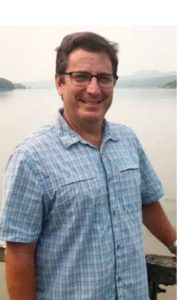 Twenty years ago, when Daniel Miller first joined NEIWPCC as an environmental analyst, he was tasked with an ambitious endeavor: develop a plan for restoring Hudson River estuary habitats — severely impacted by industrial development, transportation systems, navigational improvements, and a host of local landscape issues — back into a healthy ecosystem.
Twenty years ago, when Daniel Miller first joined NEIWPCC as an environmental analyst, he was tasked with an ambitious endeavor: develop a plan for restoring Hudson River estuary habitats — severely impacted by industrial development, transportation systems, navigational improvements, and a host of local landscape issues — back into a healthy ecosystem.
After working with multiple stakeholders over the course of many years to gather information and recommendations, Miller produced a comprehensive guide in 2011 for restoring the river’s tidal wetlands and natural shorelines and facilitating fish passage up the Hudson’s tributaries.
The “Hudson River Estuary Program Habitat Restoration Plan,” published by the New York State Department of Environmental Conservation, identified several priority habitats vital to the health and resiliency of the estuary and presented recommendations for action. The plan sets priorities for government agencies, scientists, conservation and environmental organizations and research institutions throughout the region to plan, implement and evaluate habitat restoration projects.
Miller now collaborates with a variety of partners — from local municipalities to federal agencies — to facilitate the plan’s implementation, coordinating funding sources with research and science capacities, and moving projects from preliminary stages to design and then eventually to construction. He tries to involve as many stakeholders as possible, working closely with the decision-makers while ensuring community input and support. He acknowledges that it can be difficult sometimes to get so many people to move in the same direction, but eventually they are able to come to a consensus.
“It can be a challenge when so many interested parties are involved but it is also a blessing that allows us to make progress on the Hudson,” Miller said. “There are many different ambitious and energetic groups out there doing great things for the river and the environment, and they make wonderful partners.”
In his work on shorelines, Miller also communicates extensively with communities to understand how they interact with the river. This feedback is then incorporated into shoreline designs that allow for human uses such as water access and scenic views, while still creating healthy, resilient ecosystems.
“Our primary goal is to maintain or improve the environment for the plants and animals of the Hudson River,” Miller said. “But we also have a very big component of human use that needs to be addressed. So, in working with a community we need to be really creative about what they want to experience at the river, and with a few compromises we are able to achieve a project that respects the river while satisfying those needs.”
Many of these projects are on public parklands, where visitors are constantly interacting with the river.
“We recently finished a shoreline stabilization and access project in Stuyvesant, that I’m very proud of,” Miller said. “A big priority for us was to include a large fishing platform — it’s a popular striper spot — on a section of the river where there really isn’t that much access. At the same time, we were able to build a tidal pool with tidal vegetation, and put in some shoreline features that were stable, incorporating a lot of plant matter for aquatic, terrestrial and bird life.”
Miller’s dedication to the habitat restoration came from his upbringing on the Hudson. He began working on the river when he was 18, returning to the area to raise his family after receiving his master’s in biology from Florida Atlantic University, and then working as a marine biologist in Florida and Maine. He now has his 50-ton, U.S Coast Guard commercial captain’s license for inland waters.
In his two decades at NEIWPCC, Miller has seen many colleagues come and go, as new people are hired to replace those who have retired. “I’ve come to appreciate the mix of longterm experienced people bringing their wisdom to the table with this constant renewal of young, ambitious, creative minds,” he said. “I love it when we bring in new people, because it injects some great energy and creativity into the process, which is a necessary part of being an effective and dynamic organization.”
Miller believes that it is essential to inspire people to appreciate the environment. He enjoys any opportunity to join people for a walk in the woods, or a canoe trip on the Hudson, passing on his knowledge of the river he loves.
“The hardest thing for me to see is the continued disconnect and erosion of our relationship from the environment. At best, it is seen as a novelty to a lot of kids. The more that I can get involved with people outdoors, the better.”
This story was originally printed in the Fall 2021 issue of “Interstate Waters.” Written by Amy Magin, director of NEIWPCC’s Communications Division. Daniel Miller is an environmental analyst with NEIWPCC and coordinator with the Hudson River Estuary Program Habitat Restoration.